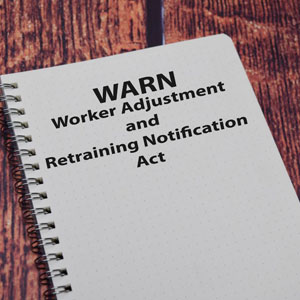
The Worker Adjustment and Retraining Notification Act (the “WARN Act” or “Act”) was enacted on August 4, 1988, and became effective on February 4, 1989, to protect American workers. The Act offers protection to workers, their families, and communities by requiring employers to provide notice 60 days in advance of covered plant closings and covered mass layoffs. Employers are legally required to provide this notice to either affected workers or their representatives, such as a labor union, to the State dislocated worker unit, and to the appropriate unit of local government.
Employers are covered by the WARN Act if they have 100 or more employees. This number does not include employees who have worked less than 6 months in the last 12 months and employees who work an average of fewer than 20 hours a week. Employees entitled to notice under the WARN Act include hourly and salaried workers, as well as supervisory and managerial employees. The Act does not provide business partners with the right to receive notice.
The Act applies to private for-profit employers and non-profit employers. Also covered are separately organized public and quasi-public entities which operate in a commercial context. The WARN Act does not apply to regular federal, state, and local government entities which provide public services.
Plant Closing
A covered employer must provide notice to workers if it is shutting down an employment site (or one or more facilities or operating units within an employment site), and the shutdown will result in a loss of employment for 50 or more employees during any 30-day period. While this does not count certain employees mentioned above who are not covered by the Act, these employees are still entitled to notice.
Mass Layoff
A covered employer must give notice for any mass layoff that does not result from a plant closing but will result in an employment loss at the employment site during any 30-day period for 500 or more employees, or 50- 499 employees if they make up at least 33% of the employer’s active workforce. While these numbers do not count certain employees mentioned above who are not covered by the Act, these employees are still entitled to notice.
An employer also must give notice if the number of employment losses which occur during a 30-day period fails to meet the threshold requirements of a plant closing or mass layoff, but the number of employment losses for 2 or more groups of workers, each of which is less than the minimum number needed to trigger notice, reaches the threshold level, during any 90-day period, of either a plant closing or mass layoff. Job losses within any 90-day period will count together toward WARN threshold levels unless the employer shows that the employment losses during the 90-day period are the result of separate and distinct causes.
If you believe that your employer is violating your rights, call Moss Bollinger for a free consultation to discuss solutions for asserting and defending these important, valuable rights. Moss Bollinger takes great pride in holding employers accountable for workplace violations that infringe upon the protections afforded every California worker by the State of California. Contact Moss Bollinger today at (310) 982-2291 or reach us online.
Get Your Questions Answered. Call For Your
Free 30 Min Evaluation Today! (310) 982-2291